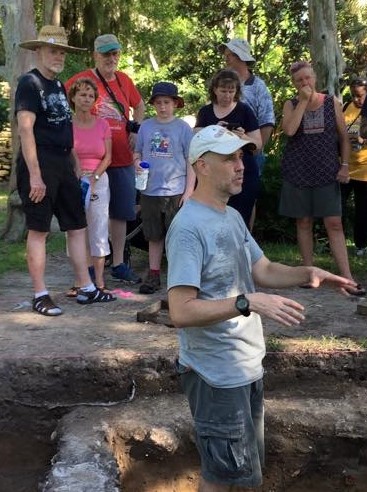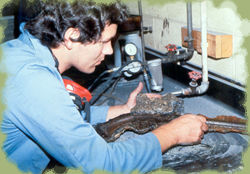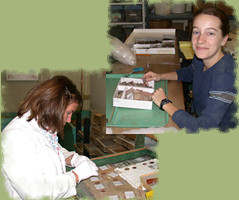Curating: Safeguarding our Treasures
Saving the archaeological past does not end with the scientific excavation of sites, or even with writing the reports about those sites. The objects themselves continue to tell us new things about colonial society as new techniques for analysis are invented, and as new researchers think of different questions to ask of the artifacts. Periodically, this new information is communicated to the public through Museum exhibits like this one.
None of this would be possible, however, if we did not maintain and curate Museum collections. Most artifacts are fragile, and deteriorate quickly unless they are kept in the proper physical conditions. Many objects- especially those of metal or organic materials- can be kept from further deterioration by specialized conservation treatment, done by professional conservators. Humidity, temperature, pest control and perhaps most importantly, acid and fume-free physical storage, have to be maintained and monitored if the artifacts are to survive. This is also true for the records associated with the artifacts—field observations and notes, maps, photographs and analysis records.
One of the most important aspects of curating a collection of artifacts is information storage and retrieval. With several million individual items, a museum—like a library—must have a catalogue that allows researchers to locate specific items—either ones they already know about, or others that they would like to know about that might be in the collection. (for example, seventeenth century beads).
 Gifford Waters: Collections manager
Gifford Waters: Collections manager
Gifford Waters is the collections manager for the historical archaeology collections at the Florida Museum of Natural History. The artifacts excavated from St. Augustine are curated at the Museum as a joint effort of the Museum, the City of St. Augustine and the Florida Department of State. As collections manager, Gifford sees that the artifacts are properly organized, labeled and stored. He monitors them for signs of deterioration, and supervises student workers in the handling and labeling of objects. Collections managers also organize and maintain both paper and electronic databases of the objects’ associated records, and help researchers find their way around the collections. The St. Augustine collections consist of more than 1.5 million items, many of which are used by researchers nationwide for exhibits and study.
 James Levy: Conservator
James Levy: Conservator
James Levy, a conservator with the Florida Bureau of Archaeological Research Conservation Lab, has treated hundreds of objects from St. Augustine over the years. Objects of metals, wood, leather, pottery, bone and shell all require specialized chemical and mechanical treatments.
 Korinn and Shanna: Museum Technicians
Korinn and Shanna: Museum Technicians
Objects to be curated must be cleaned, labeled, placed in marked boxes of appropriate materials, and stored in labeled cabinets. This information, along with the artifact’s original field information must then be entered into the curation database. The field records and lab records associated with the objects must also be duplicated, bound, and stored in a way that allows for easy retrieval. At the Florida Museum of Natural History, these tasks are usually done by curation technicians or rotating Museum student interns.